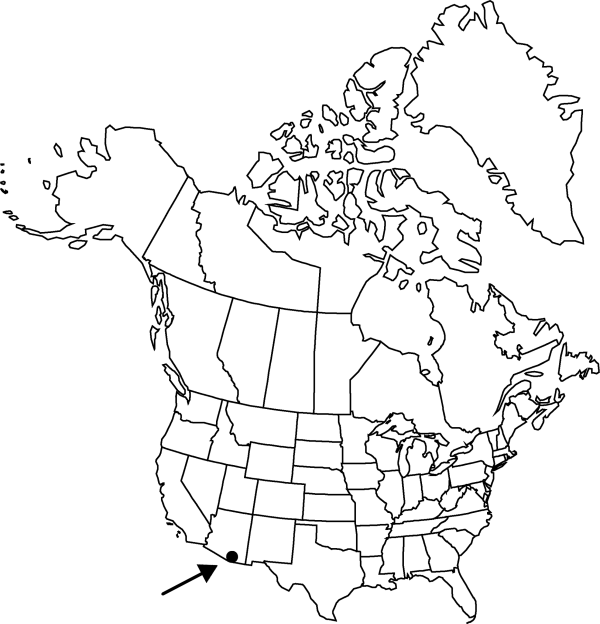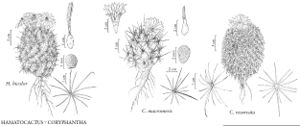FNA>Volume Importer |
FNA>Volume Importer |
| Line 20: |
Line 20: |
| | }}<!-- | | }}<!-- |
| | | | |
| − | --><span class="statement" id="st-d0_s0" data-properties="plant architecture;plant architecture;plant architecture;plant diameter;age life cycle;stem count;spine fixation"><b>Plants </b>unbranched or few branched, except in old age, ultimately forming mounds, rarely to 1 m diam., stems to 50, with most spines pressed against stem outline.</span> <span class="statement" id="st-d0_s1" data-properties="root density"><b>Roots </b>± diffuse.</span> <span class="statement" id="st-d0_s2" data-properties="stem shape;stem shape;stem shape;stem shape;stem atypical length;stem length;stem atypical width;stem width"><b>Stems </b>spheric to broadly short cylindric, 10–25 (–30) × (7.5–) 10–15 cm;</span> <span class="statement" id="st-d0_s3" data-properties="tubercle length;tubercle width;tubercle texture">tubercles 6–10 × 6 mm, firm;</span> <span class="statement" id="st-d0_s4" data-properties="areolar gland prominence">areolar glands seasonally conspicuous;</span> <span class="statement" id="st-d0_s5" data-properties="pith count">pith 1/5 of lesser stem diam.;</span> <span class="statement" id="st-d0_s6" data-properties="medullary system architecture;medullary system prominence">medullary vascular system conspicuous.</span> <span class="statement" id="st-d0_s7" data-properties="spine count;spine coloration;spine coloration;largest spine coloration;largest spine shape;tip coloration"><b>Spines </b>12–20 per areole, tan or yellow, largest spines turning gray with red tips, all nearly terete;</span> <span class="statement" id="st-d0_s8" data-properties="spine arrangement;spine atypical count;spine count;spine some measurement;spine diameter">radial spines (12–) 15–20 per areole, 12–15 mm, basally 0.5 mm diam.;</span> <span class="statement" id="st-d0_s9" data-properties="central spine atypical count;central spine count;central spine orientation;central spine atypical some measurement;central spine some measurement;central spine diameter">central spines 1 (–2) per areole, decurved, (15–) 20 mm, usually less than 1 mm diam.</span> <span class="statement" id="st-d0_s10" data-properties="flower arrangement;flower length;flower width;portion position or shape"><b>Flowers </b>distant from stem apex, forming ring around distal portion of stem, 25–40 × 25–40 mm;</span> <span class="statement" id="st-d0_s11" data-properties="outer tepal shape">outer tepals denticulate;</span> <span class="statement" id="st-d0_s12" data-properties="inner tepal count;inner tepal coloration;inner tepal coloration;inner tepal length;inner tepal width">inner tepals 20–30 per flower, greenish yellow or lemon yellow, 18 × 3–4.5 mm;</span> <span class="statement" id="st-d0_s13" data-properties="anther coloration">anthers pale-yellow;</span> <span class="statement" id="st-d0_s14" data-properties="stigma lobe count;stigma lobe coloration;stigma lobe some measurement">stigma lobes ca. 5, pale green (requiring verification), ca. 2.5–2.8 mm.</span> <span class="statement" id="st-d0_s15" data-properties="fruit coloration;fruit coloration;fruit coloration;fruit coloration;fruit condition;pulp reflectance;pulp coloration;pulp length or size;pulp shape;pulp shape;pulp atypical length;pulp length;pulp atypical width;pulp width;pulp count or density"><b>Fruits </b>greenish white (drying yellow-green) to partly or wholly tinted with dull reddish-brown, usually 1.5–2 times longer than thick, spheric or elongate, 9–12 (–13) × (4–) 5–7 mm, pulp sparse and soon drying;</span> <span class="statement" id="st-d0_s16" data-properties="floral remnant duration">floral remnant strongly persistent.</span> <span class="statement" id="st-d0_s17" data-properties="seed coloration;seed shape;seed architecture or coloration or relief"><b>Seeds </b>bright brown, spheric, finely and weakly raised-reticulate.</span><!-- | + | --><span class="statement" id="st-undefined" data-properties=""><b>Plants </b>unbranched or few branched, except in old age, ultimately forming mounds, rarely to 1 m diam., stems to 50, with most spines pressed against stem outline. <b>Roots</b> ± diffuse. <b>Stems</b> spheric to broadly short cylindric, 10–25(–30) × (7.5–)10–15 cm; tubercles 6–10 × 6 mm, firm; areolar glands seasonally conspicuous; pith 1/5 of lesser stem diam.; medullary vascular system conspicuous. <b>Spines</b> 12–20 per areole, tan or yellow, largest spines turning gray with red tips, all nearly terete; radial spines (12–)15–20 per areole, 12–15 mm, basally 0.5 mm diam.; central spines 1(–2) per areole, decurved, (15–)20 mm, usually less than 1 mm diam. <b>Flowers</b> distant from stem apex, forming ring around distal portion of stem, 25–40 × 25–40 mm; outer tepals denticulate; inner tepals 20–30 per flower, greenish yellow or lemon yellow, 18 × 3–4.5 mm; anthers pale yellow; stigma lobes ca. 5, pale green (requiring verification), ca. 2.5–2.8 mm. <b>Fruits</b> greenish white (drying yellow-green) to partly or wholly tinted with dull reddish brown, usually 1.5–2 times longer than thick, spheric or elongate, 9–12(–13) × (4–)5–7 mm, pulp sparse and soon drying; floral remnant strongly persistent. <b>Seeds</b> bright brown, spheric, finely and weakly raised-reticulate.</span><!-- |
| | | | |
| | -->{{Treatment/Body | | -->{{Treatment/Body |
| | + | |phenology=Flowering summer; fruiting winter (Nov–Jan). |
| | |habitat=Valleys, mesas, foothills, grasslands, oak belts, grassy or rocky areas | | |habitat=Valleys, mesas, foothills, grasslands, oak belts, grassy or rocky areas |
| | |elevation=1200-1800 m | | |elevation=1200-1800 m |
| Line 41: |
Line 42: |
| | |basionyms=Mammillaria recurvata | | |basionyms=Mammillaria recurvata |
| | |family=Cactaceae | | |family=Cactaceae |
| | + | |phenology=Flowering summer; fruiting winter (Nov–Jan). |
| | |habitat=Valleys, mesas, foothills, grasslands, oak belts, grassy or rocky areas | | |habitat=Valleys, mesas, foothills, grasslands, oak belts, grassy or rocky areas |
| | |elevation=1200-1800 m | | |elevation=1200-1800 m |
| Line 48: |
Line 50: |
| | |publication year=1923 | | |publication year=1923 |
| | |special status= | | |special status= |
| − | |source xml=https://jpend@bitbucket.org/aafc-mbb/fna-fine-grained-xml.git/src/287ef3db526bd807d435a3c7423ef2df1e951227/V4/V4_415.xml | + | |source xml=https://jpend@bitbucket.org/aafc-mbb/fna-data-curation.git/src/9216fc802291cd3df363fd52122300479582ede7/coarse_grained_fna_xml/V4/V4_415.xml |
| | |subfamily=Cactaceae subfam. Cactoideae | | |subfamily=Cactaceae subfam. Cactoideae |
| | |genus=Coryphantha | | |genus=Coryphantha |
| | |species=Coryphantha recurvata | | |species=Coryphantha recurvata |
| − | |age life cycle=old
| |
| − | |anther coloration=pale-yellow
| |
| − | |areolar gland prominence=conspicuous
| |
| − | |central spine atypical count=1;2
| |
| − | |central spine atypical some measurement=15mm;20mm
| |
| − | |central spine count=1
| |
| − | |central spine diameter=0mm;1mm
| |
| − | |central spine orientation=decurved
| |
| − | |central spine some measurement=20
| |
| − | |floral remnant duration=persistent
| |
| − | |flower arrangement=distant
| |
| − | |flower length=25mm;40mm
| |
| − | |flower width=25mm;40mm
| |
| − | |fruit coloration=greenish white;partly or wholly tinted
| |
| − | |fruit condition=drying
| |
| − | |inner tepal coloration=lemon yellow;greenish yellow
| |
| − | |inner tepal count=20;30
| |
| − | |inner tepal length=18
| |
| − | |inner tepal width=3mm;4.5mm
| |
| − | |largest spine coloration=gray
| |
| − | |largest spine shape=terete
| |
| − | |medullary system architecture=vascular
| |
| − | |medullary system prominence=conspicuous
| |
| − | |outer tepal shape=denticulate
| |
| − | |pith count=1/5
| |
| − | |plant architecture=branched;few;unbranched
| |
| − | |plant diameter=0m;1m
| |
| − | |portion position or shape=distal
| |
| − | |pulp atypical length=12mm;13mm
| |
| − | |pulp atypical width=4mm;5mm
| |
| − | |pulp coloration=reddish-brown
| |
| − | |pulp count or density=sparse
| |
| − | |pulp length=9mm;12mm
| |
| − | |pulp length or size=longer
| |
| − | |pulp reflectance=dull
| |
| − | |pulp shape=elongate;spheric
| |
| − | |pulp width=5mm;7mm
| |
| − | |root density=diffuse
| |
| − | |seed architecture or coloration or relief=raised-reticulate
| |
| − | |seed coloration=bright brown
| |
| − | |seed shape=spheric
| |
| − | |spine arrangement=radial
| |
| − | |spine atypical count=12;15
| |
| − | |spine coloration=yellow;tan
| |
| − | |spine count=15;20
| |
| − | |spine diameter=0.5
| |
| − | |spine fixation=pressed
| |
| − | |spine some measurement=12mm;15mm
| |
| − | |stem atypical length=25cm;30cm
| |
| − | |stem atypical width=7.5cm;10cm
| |
| − | |stem count=0;50
| |
| − | |stem length=10cm;25cm
| |
| − | |stem shape=spheric;broadly short cylindric
| |
| − | |stem width=10cm;15cm
| |
| − | |stigma lobe coloration=pale green
| |
| − | |stigma lobe count=5
| |
| − | |stigma lobe some measurement=2.5mm;2.8mm
| |
| − | |tip coloration=red
| |
| − | |tubercle length=6mm;10mm
| |
| − | |tubercle texture=firm
| |
| − | |tubercle width=6
| |
| | }}<!-- | | }}<!-- |
| | | | |
| | -->[[Category:Treatment]][[Category:Coryphantha]] | | -->[[Category:Treatment]][[Category:Coryphantha]] |
Plants unbranched or few branched, except in old age, ultimately forming mounds, rarely to 1 m diam., stems to 50, with most spines pressed against stem outline. Roots ± diffuse. Stems spheric to broadly short cylindric, 10–25(–30) × (7.5–)10–15 cm; tubercles 6–10 × 6 mm, firm; areolar glands seasonally conspicuous; pith 1/5 of lesser stem diam.; medullary vascular system conspicuous. Spines 12–20 per areole, tan or yellow, largest spines turning gray with red tips, all nearly terete; radial spines (12–)15–20 per areole, 12–15 mm, basally 0.5 mm diam.; central spines 1(–2) per areole, decurved, (15–)20 mm, usually less than 1 mm diam. Flowers distant from stem apex, forming ring around distal portion of stem, 25–40 × 25–40 mm; outer tepals denticulate; inner tepals 20–30 per flower, greenish yellow or lemon yellow, 18 × 3–4.5 mm; anthers pale yellow; stigma lobes ca. 5, pale green (requiring verification), ca. 2.5–2.8 mm. Fruits greenish white (drying yellow-green) to partly or wholly tinted with dull reddish brown, usually 1.5–2 times longer than thick, spheric or elongate, 9–12(–13) × (4–)5–7 mm, pulp sparse and soon drying; floral remnant strongly persistent. Seeds bright brown, spheric, finely and weakly raised-reticulate.
Phenology: Flowering summer; fruiting winter (Nov–Jan).
Habitat: Valleys, mesas, foothills, grasslands, oak belts, grassy or rocky areas
Elevation: 1200-1800 m
Distribution
Ariz., Mexico (Sonora).
Discussion
Selected References
None.

